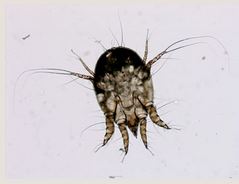



Imported Cattle End 30 Year Scab Free Run For Scots
UK, SCOTLAND – A skin piercing cattle mite causing severe dermatitis has been confirmed in Scotland after being reintroduced after 30 years by imported livestock.Farmers are being urged to report suspect cases of cattle scab after Scottish Agriculture College laboratories confirmed infection on a Borders region farm.
An imported cow-calf duo from outside Great Britain was confirmed with the condition, known formally as psoroptic mange and not seen in Scotland since the early 1980's.
In 2011, Moredun Research Institute (MRI) and SAC veterinarians issued warnings that farmers exercise care when importing cattle.
The condition, yielding a single case in Scotland, is a greater issue on the continent, the source of the problem, according to epidemiologists.

Europe’s beef farms are worst affected, with dairy farms reporting fewer infections. The Scottish Rural College reported that cattle scab is Belgium’s most costly ectoparasitic disease.
Caused by psoroptic mites, it means immense irritation to the skin, often appearing on the back, tail head and shoulders and veterinary expert Helen Carty has urged farmers to spot cattle scab early.
“I would urge farmers to remain vigilant for any signs of cattle scab and to notify their vet of any suspect cases,” said Mr Carty.
“Cattle scab is a severe skin disease, with serious welfare implications for cattle if not quickly identified and treated correctly. It has the potential to become established in Scotland because of the movement of animals and the difficulties of treatment."
Heightened biosecurity has been called for by National Farmers Union (NFU) Scotland President Nigel Miller.
His organisation has pleaded with the Scottish Ministers to revisit the question of making cattle scab a notifiable disease.
Mr Miller said the NFU has been aware of the dangers: “NFU Scotland has been concerned about the possible spread of cattle psoroptes into Scotland for a number of years and has issued warnings on several occasions to our members, alerting them to the risks if importing cattle from high risk areas.
“It is imperative that infected cattle are locked-down for transport if this parasite is not to become an endemic problem in Scotland.
“If it does become endemic it will affect the status of Scottish cattle and undo the hard work of the industry to establish a reputation for quality within Scottish cattle.”
Difficulty in identifying early infections has been the subject of a MRI study, explained Moredun senior scientist Dr Alasdair Nisbet.
Dr Nisbet said: “Cattle may not show signs immediately after infection, allowing the silent spread of disease within, and between, herds.
“At Moredun we have been adapting the diagnostic blood test for sheep scab to detect mange cases in cattle.
“To determine the sensitivity and specificity of the test, that’s its ability to detect disease and tell us if disease is not present, we have been working closely with colleagues from SAC Consulting, AHVLA and vets from Belgium where this disease is a common affliction of Belgian Blue cattle.”
Once diagnosed, treating cattle scab is not simple, warned Helen Carty this week.
“All the animals in the group, and any other in-contact animals, regardless of whether they are showing clinical signs, must be treated,” she advised. “Experience in Wales suggests the mites are resistant to commonly used products and none are licensed for use in milking dairy cows.”
Michael Priestley
News Team - Editor
Mainly production and market stories on ruminants sector. Works closely with sustainability consultants at FAI Farms



